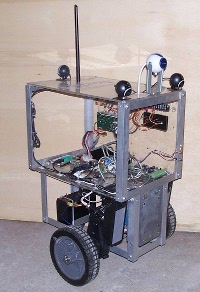Update
I did a presentation at MIT on January 19, 2011 for BLU (Boston Linux Unix user Group). I'll make my presentation available on this sit after I do some edits.
I could not get the network setup for the robot. My underlying assumption that if I brought my own wireless access point and managed my own network that it would "just work" proved incorrect. I could not get reliable connectivity.(It may have had to do with MIT's internal wireless network.)
I've had it with the EPIA motherboard, its USB chipset seems basically broken. Its dreadfully under powered and it needs a fan. I just purchased an Intel D510MO Dual core Atom processor ITX motherboard. I have no first hand experience with it, but it seems to support 64bit (yea!) and use only about 50w power, 50w is kind of a lot, but that's still a couple hours on one battery.

Not sure solar makes sense here
The robot is primarily and indoor robot, and thus solar batteries would probably not produce much power.
Regenerative braking is an interesting idea, but, again, there isn't much velocity so there isn't much power to be reclaimed. The PID motor control and the PWM motor driver is pretty efficient and doesn't waist much power.
There are two things that use power, the computer electronics and the motors. The computer uses power while the robot is on. The motors only use power when applying torque. Properly sizing the computer, peripherals, RAM, etc. can reduce power drain more than a reasonably sized solar panel can produce power in-doors.
trickle charge?
Hello, I just found your site while looking for an alternative to the Phidgets SBC, which is a reasonably expensive bit of kit here in the UK.
I'm quite excited to see what you have done with your robot - it looks a lot like the one I had sort of mentally planned. If its ok, I couldn't mind shooting some ideas at you in an email, if you can bear the idea of swapping emails with an enthusiast, but very definite beginner to robotics.
In the post above, you mentioned a concern for the battery life of the robot. Energy scavenging is one of the topics I find myself turning over in my head a lot, on the basis that energy wasted is an opportunity lost.
While it may not be enough to provide a full running charge of the battery, have you considered adding a few small strategically placed solar panels on the chassis? as I say, while it won't be enough to provide a running charge, enough of them should provide a trickle charge and act as a battery extender, surely? while not as efficient indoors as they are outdoors, they still provide a usable charge.
Forgive any strangely placed words in the above, the autocorrect on my Android phone has a strange sense of humour at times.
Regards,
Alan